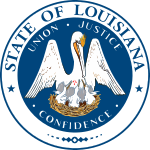This article includes a list of general references, but it lacks sufficient corresponding inline citations .(June 2014) |
| |||||||||||||||||
| |||||||||||||||||
 Parish Results Blanchard: 50-60% 60-70% 70-80% 80-90% >90% Parker: 50-60% 60-70% 70-80% | |||||||||||||||||
| |||||||||||||||||
| Elections in Louisiana |
|---|
 |
The 1916 Louisiana gubernatorial election was held on April 18, 1916. Like most Southern states between the Reconstruction Era and the Civil Rights Movement, Louisiana's Republican Party was virtually nonexistent in terms of electoral support. This meant that the Democratic Party primary held on January 25 was supposed to be the real contest over who would be governor. However, in this particular election Progressive Party nominee John M. Parker ran an unusually competitive campaign, garnering 37% of the general election vote. The election resulted in the election of Democrat Ruffin G. Pleasant as governor of Louisiana.

